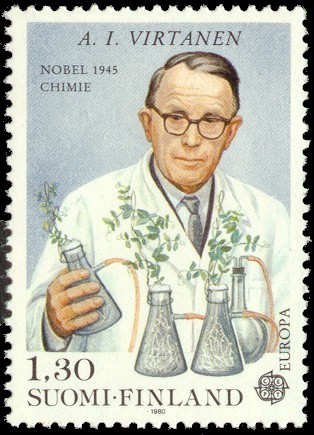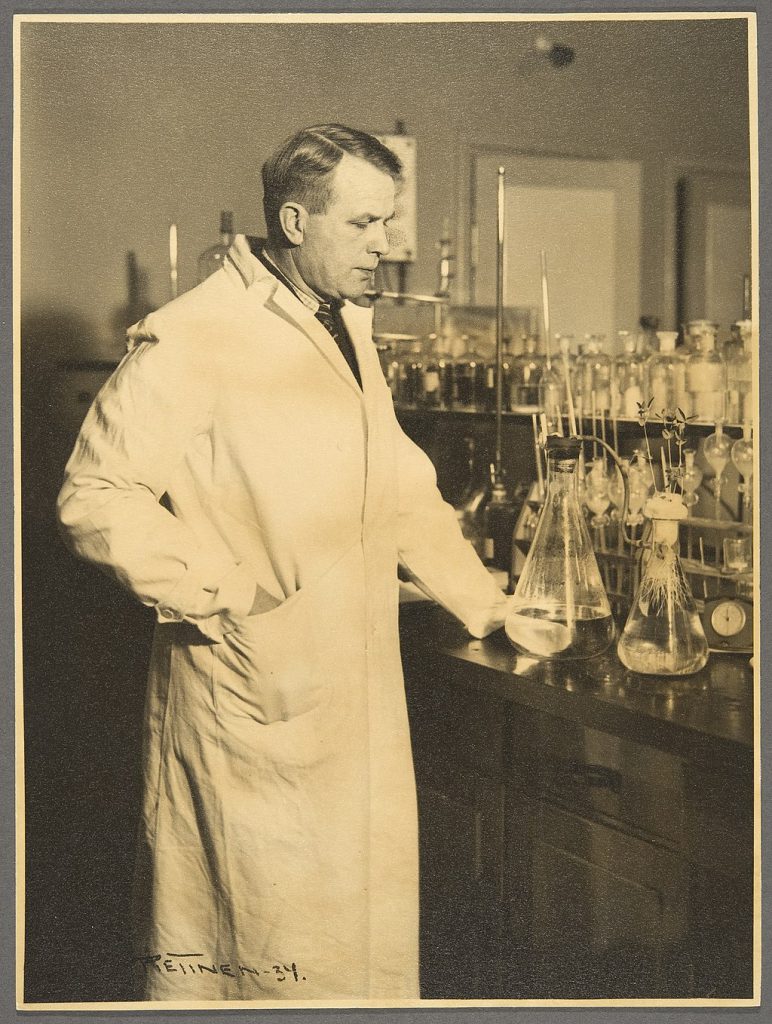
Artturi Virtanen (1895-1973), Finnish post stamp, 1980
On January 15, 1895, Finnish chemist and Nobel Laureate Artturi Ilmari Virtanen was born. Virtanen invented AIV silage which improved milk production and a method of preserving butter, the AIV salt, which led to increased Finnish butter exports.
Artturi Virtanen – Youth and Education
Artturi Ilmari Virtanen was born in Helsinki, Finland, the son of Kaarlo Virtanen and Serafiina Isotalo. He received his school education in the Viipuri grammar school (Vyborg), after which he studied chemistry, biology and physics at the local university from 1913. He graduated in 1919 and began studying in Zurich in under G. Wiegner, bacteriology in Stockholm Chr. Barthel, and enzymology in Stockholm under H. von Euler. During the mid-1920s, Virtanen’s interest turned to biochemistry.
Academic Career
While still studying at the University of Helsinki Virtanen became first-assistant of the Central Laboratory of Industries at Helsinki and later worked at the Laboratory of Valio, Finnish Cooperative Dairies’ Association as a chemist. He became the director of this laboratory during the 1920s and later also of the Biochemical Research Institute at Helsinki. Next to his research efforts, Artturi Ilmari Virtanen also taught chemistry at the University of Helsinki during these years and was later also appointed Professor of Biochemistry at the Finland Institute of Technology at Helsinki and at the University of Helsinki.
Research on the Ingredients of Plant Food
The work of Artturi Virtanen concentrated mainly on the ingredients of plant food. For example, he studied the biosynthesis of vitamins and was able to isolate numerous new constituents from plants and investigate their importance for nutrition. Around 1925 Artturi Virtanen’s research interest shifted towards the nitrogen-fixing bacteria in the root nodules of leguminous plants. The improved methods of butter preservation, by adding disodium phosphate to prevent acidic hydrolysis. The method was used for several decades in Finland. Virtanen invented a fodder preservation method (AIV Fodder) between 1925 and 1932, which was a kind of silage that improved the storage of green fodder, which is important during long winters. The process includes adding dilute hydrochloric or sulfuric acid to newly stored grain. Increased acidity stops harmful fermentation and has no adverse effect on the nutritive value of the fodder or the animals it is fed to.

Virtanen at his laboratory in 1934
He was able to identify the red pigment Legoglobin of bacteria and found a close chemical relationship with the blood pigment haemoglobin and its importance in the absorption of gases. Further investigations concentrated on fermentation processes in the soil, the acidity of soils and the way of life of soil bacteria. In biochemical processes, he also concentrated on nitrate uptake in plants and the production of vitamins, amino acids and proteins. Among other things, he isolated new forms of ketocarboxylic acids, aminocarboxylic acids, sulphur-containing compounds and antibacterial ingredients of onions and garlic.
The 1945 Nobel Prize in Chemistry
In 1945, Virtanen received the Nobel Prize in chemistry primarily for the development of the AIV method for preserving animal feed, which does not destroy important ingredients such as vitamins. He achieved this by using special silage methods after harvesting protein-rich fodder plants. Later, he also developed a method for milk production using protein-free cows’ nutrition. The prestige conferred by the Nobel Prize brought Virtanen invitations, honorary doctorates and membership in foreign academies of science. He was a member of the Finnish, Norwegian, Swedish, Flemish, Bavarian, and Pontifical Academies of Science, and of the Swedish and Danish Academies of Engineering Sciences. He was an honorary member of learned societies in Finland, Sweden, Austria, Edinburgh, and the US, and received honorary degrees of the Universities of Lund, Paris, Giessen, and Helsinki, the Royal Technical College at Stockholm, and the Finland Institute of Technology.
Starting from 1948 Virtanen was a member and President of the State Academy of Science and Arts in Finland. From 1949 he was a corresponding member of the Bavarian Academy of Sciences . In 1963 he was elected a member of the German Academy of Natural Scientists Leopoldina, in 1969 to the National Academy of Sciences. During his later research, he developed partially synthetic cattle feeds and he headed the Valio Laboratory until the late 1960s. Artturi Virtanen died of pneumonia in November 1973, at age 78, following a broken femur from a fall few weeks prior.
A.I Virtanen: The man behind the quality | Valio International, [5]
References and Further Reading:
- [1] Artturi Virtanen at the Nobel Prize Foundation Webpage
- [2] Artturi Virtanen at Britannica
- [3] Artturi Virtanen at Famous Scientists
- [4] Arrturi Virtanen at Wikidata
- [5] A.I Virtanen: The man behind the quality | Valio International, Valio @ youtube
- [6] Miettinen, Jorma K. (1975). “Artturi Ilmari Virtanen”. Plant and Soil. 43 (1–3): 229–234. doi:10.1007/BF01928489
- [7] R. A. Kyle; M. A. Shampo (1981). “Artturi Ilmari Virtanen”. Journal of the American Medical Association. 246 (2): 150. doi:10.1001/jama.246.2.150
- [8] Timeline for Artturi Virtanen,via Wikidata






Pingback: Whewell’s Gazette: Year 3, Vol. #23 | Whewell's Ghost